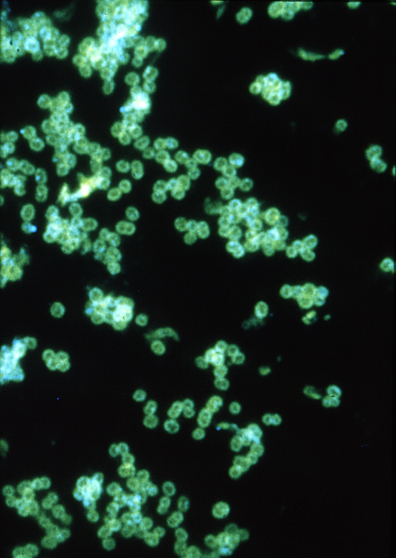Neisseria
| Neisseria | ||||||||||||
|---|---|---|---|---|---|---|---|---|---|---|---|---|
 Fluorescent antibody stain of Neisseria gonorrhoeae.
| ||||||||||||
| Scientific classification | ||||||||||||
|
|
WikiDoc Resources for Neisseria |
|
Articles |
|---|
|
Most recent articles on Neisseria |
|
Media |
|
Evidence Based Medicine |
|
Clinical Trials |
|
Ongoing Trials on Neisseria at Clinical Trials.gov Clinical Trials on Neisseria at Google
|
|
Guidelines / Policies / Govt |
|
US National Guidelines Clearinghouse on Neisseria
|
|
Books |
|
News |
|
Commentary |
|
Definitions |
|
Patient Resources / Community |
|
Patient resources on Neisseria Discussion groups on Neisseria Directions to Hospitals Treating Neisseria Risk calculators and risk factors for Neisseria
|
|
Healthcare Provider Resources |
|
Causes & Risk Factors for Neisseria |
|
Continuing Medical Education (CME) |
|
International |
|
|
|
Business |
|
Experimental / Informatics |
Editor-In-Chief: C. Michael Gibson, M.S., M.D. [1]
Overview
Neisseria is a genus of bacteria included among the proteobacteria, a large group of Gram-negative forms. Neisseria are diplococci that resemble coffee beans when viewed microscopically.[1] The genus includes the species N. gonorrhoeae (also called the gonococcus), which causes gonorrhoea, and N. meningitidis (also called the meningococcus), one of the most common causes of bacterial meningitis and the causative agent of meningococcal septicaemia.
This genus also contains several, believed to be nonpathogenic species, like:
- Neisseria cinerea
- Neisseria elongata
- Neisseria flavescens
- Neisseria lactamica
- Neisseria mucosa
- Neisseria polysaccharea
- Neisseria sicca
- Neisseria subflava
History
The genus Neisseria is named after the German bacteriologist Albert Neisser, who discovered its first example, Neisseria gonorrheae, the pathogen which causes the human disease gonorrhea. Neisser also co-discovered the pathogen that causes leprosy, Mycobacterium leprae. These discoveries were made possible by the development of new staining techniques which he helped to develop.
Biochemical Indentification
All the medically significant species of Neisseria are positive for both catalase and oxidase. Different Neisseria species can be identified by the sets of sugars from which they will produce acid. For example, N. gonorrheae makes acid from only glucose, however N. meningitidis produces acid from both glucose and maltose.
References
- ↑ Ryan KJ; Ray CG (editors) (2004). Sherris Medical Microbiology (4th ed. ed.). McGraw Hill. ISBN 0-8385-8529-9.